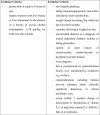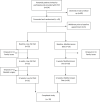Impact of a Mediterranean diet on hepatic and metabolic outcomes in non-alcoholic fatty liver disease: The MEDINA randomised controlled trial
- PMID: 35357066
- PMCID: PMC9544144
- DOI: 10.1111/liv.15264
Impact of a Mediterranean diet on hepatic and metabolic outcomes in non-alcoholic fatty liver disease: The MEDINA randomised controlled trial
Abstract
Background: Non-alcoholic fatty liver disease (NAFLD) is predominantly managed by lifestyle intervention, in the absence of effective pharmacotherapies. Mediterranean diet (MedDiet) is the recommended diet, albeit with limited evidence.
Aims: To compare an ad libitum MedDiet to low-fat diet (LFD) in patients with NAFLD for reducing intrahepatic lipids (IHL) by proton magnetic resonance spectroscopy (1 H-MRS). Secondary outcomes include insulin resistance by homeostatic model of assessment (HOMA-IR), visceral fat by bioelectrical impedance analysis (BIA), liver stiffness measurement (LSM) and other metabolic outcomes.
Methods: In this parallel multicentre RCT, subjects were randomised (1:1) to MedDiet or LFD for 12 weeks.
Results: Forty-two participants (25 females [60%], mean age 52.3 ± 12.6 years) were included, 23 randomised to LFD and 19 to MedDiet.; 39 completed the study. Following 12 weeks, there were no between-group differences. IHL improved significantly within the LFD group (-17% [log scale]; p = .02) but not within the MedDiet group (-8%, p = .069). HOMA-IR reduced in the LFD group (6.5 ± 5.6 to 5.5 ± 5.5, p < .01) but not in the MedDiet group (4.4 ± 3.2 to 3.9 ± 2.3, p = .07). No differences were found for LSM (MedDiet 7.8 ± 4.0 to 7.6 ± 5.2, p = .429; LFD 11.8 ± 14.3 to 10.8 ± 10.2 p = .99). Visceral fat reduced significantly in both groups; LFD (-76% [log scale], p = <.0005), MedDiet (-61%, p = <.0005).
Conclusions: There were no between-group differences for hepatic and metabolic outcomes when comparing MedDiet to LFD. LFD improved IHL and insulin resistance. Significant improvements in visceral fat were seen within both groups. This study highlights provision of dietary interventions in free-living adults with NAFLD is challenging.
Keywords: Mediterranean diet; dietary patterns; intrahepatic lipids; low-fat diet; non-alcoholic fatty liver disease; non-alcoholic steatohepatitis.
© 2022 The Authors. Liver International published by John Wiley & Sons Ltd.
Conflict of interest statement
All authors have no perceived conflict of interest to declare.
Figures
References
-
- Wah‐Kheong C, Khean‐Lee G. Epidemiology of a fast emerging disease in the Asia‐Pacific region: non‐alcoholic fatty liver disease. Hepatol Int. 2013;7(1):65‐71. - PubMed
-
- Ratziu V, Bellentani S, Cortez‐Pinto H, Day C, Marchesini G. A position statement on NAFLD/NASH based on the EASL 2009 special conference. J Hepatol. 2010;53(2):372‐384. - PubMed
-
- Lonardo A, Bellentani S, Argo CK, et al. Epidemiological modifiers of non‐alcoholic fatty liver disease: focus on high‐risk groups. Dig Liver Dis. 2015;47(12):997‐1006. - PubMed
-
- Tarantino G, Conca P, Pasanisi F, et al. Could inflammatory markers help diagnose nonalcoholic steatohepatitis? Eur J Gastroenterol Hepatol. 2009;21(5):504‐511. - PubMed
Publication types
MeSH terms
LinkOut - more resources
Full Text Sources
Medical



